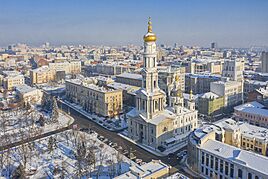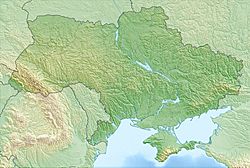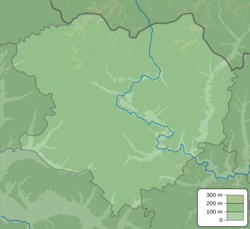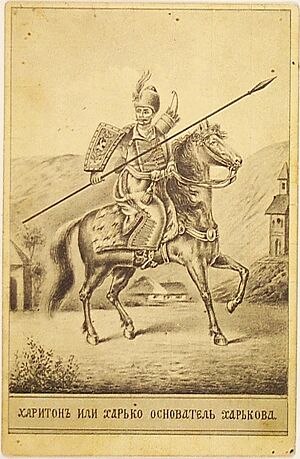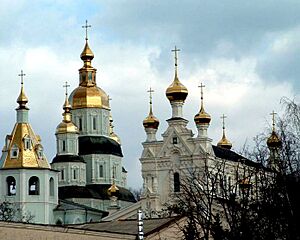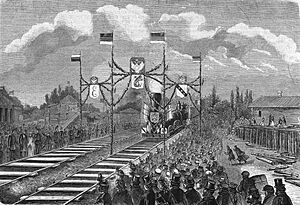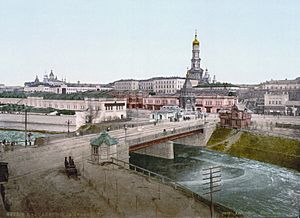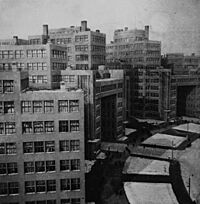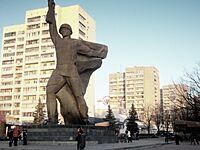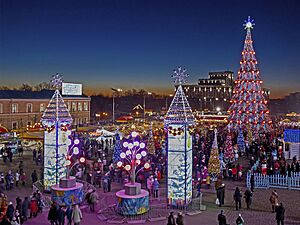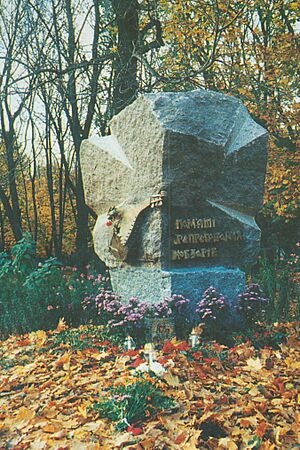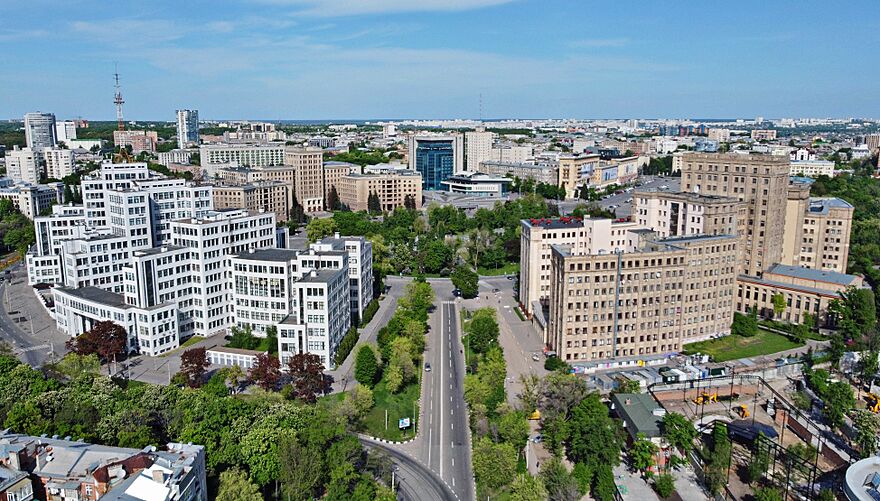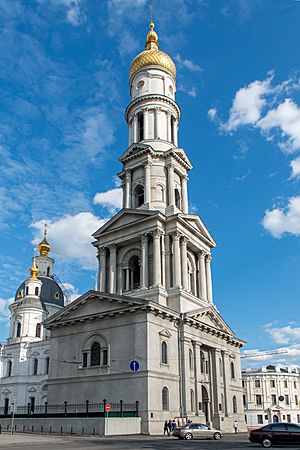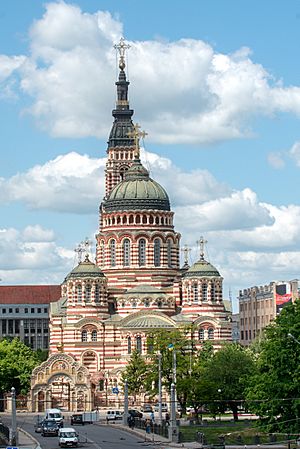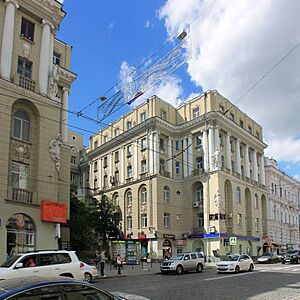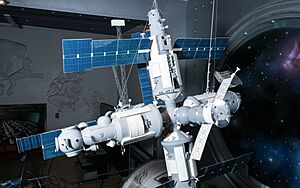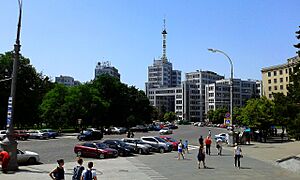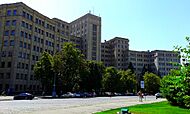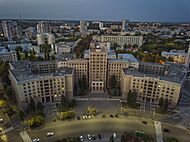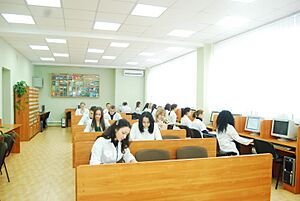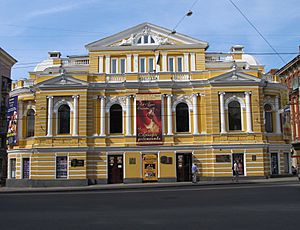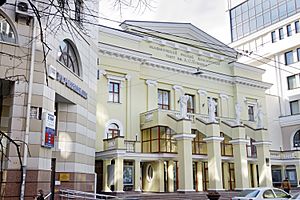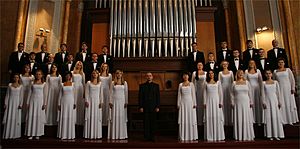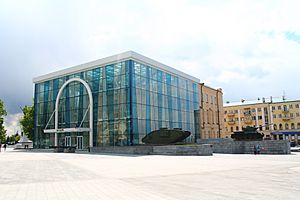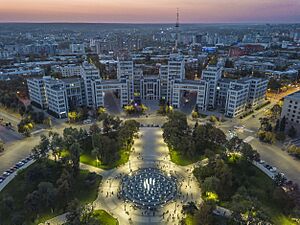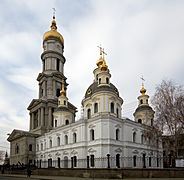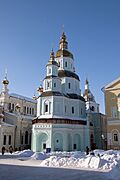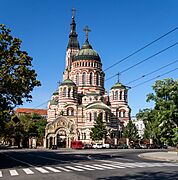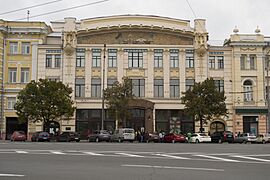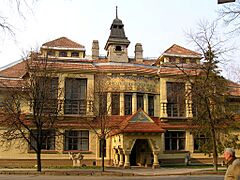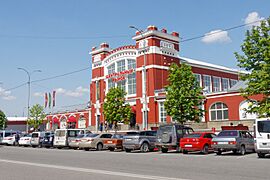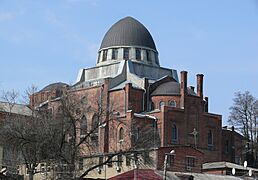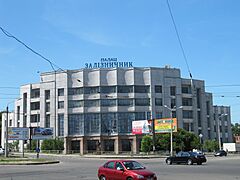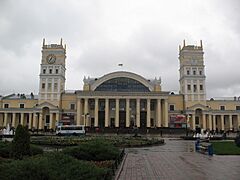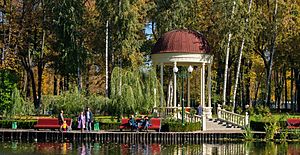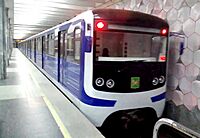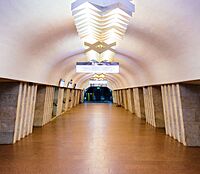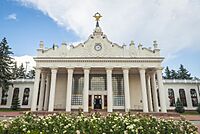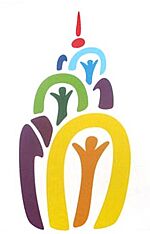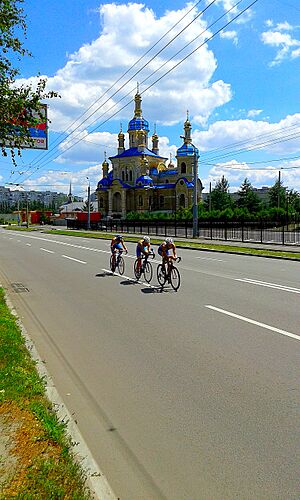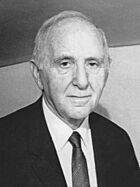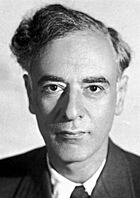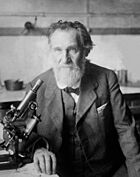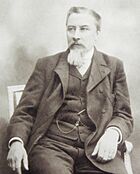Kharkiv facts for kids
Quick facts for kids
Kharkiv
Харків
|
|||||
|---|---|---|---|---|---|
| Ukrainian transcription(s) | |||||
| • National, ALA-LC, BGN/PCGN | Kharkiv | ||||
| • Scholarly | Charkiv | ||||
|
Clockwise from top: Assumption Cathedral, Kharkiv railway station, National University of Kharkiv, Kharkiv city council
|
|||||
|
|||||
| Nickname(s):
Smart City
|
|||||
| Country | |||||
| Oblast | Kharkiv Oblast | ||||
| Raion | Kharkiv Raion | ||||
| Hromada | Kharkiv urban hromada | ||||
| Founded | 1654 | ||||
| Districts |
List of 9
Shevchenkivskyi District
Novobavarskyi District Kyivskyi District Slobidskyi District Kholodnohirskyi District Saltivskyi District Nemyshlianskyi District Industrialnyi District Osnovianskyi District |
||||
| Area | |||||
| • City | 350 km2 (140 sq mi) | ||||
| • Metro | 3,223 km2 (1,244 sq mi) | ||||
| Elevation | 152 m (499 ft) | ||||
| Population
(April 1, 2024 estimate)
|
|||||
| • City | 956,774 |
||||
| • Rank | 2nd in Ukraine | ||||
| • Density | 4,500/km2 (12,000/sq mi) | ||||
| • Metro | 1,729,049 | ||||
| Demonym(s) | Kharkivite | ||||
| Time zone | UTC+2 (EET) | ||||
| • Summer (DST) | UTC+3 (EEST) | ||||
| Postal code |
61001–61499
|
||||
| Licence plate | AX, KX, ХА (old), 21 (old) | ||||
| Sister cities | Albuquerque, Bologna, Cincinnati, Kaunas, Lille, Nuremberg, Poznań, Tianjin, Jinan, Kutaisi, Varna, Rishon LeZion, Brno, Daugavpils | ||||
Kharkiv is the second-largest city in Ukraine. It is located in the northeast part of the country. Kharkiv is a major center for culture, science, education, and industry in Ukraine. It has many museums, theaters, and libraries. The city is also known for its important industries, especially in machinery and electronics.
Kharkiv was founded in 1654 as a fortress. Over time, it grew into a big city. It became an important place for industry, trade, and Ukrainian culture. From 1919 to 1934, Kharkiv was the capital of the Ukrainian Soviet Socialist Republic.
Contents
History of Kharkiv
Russian Tsardom / Russian Empire (1654–1917)
Ukrainian People's Republic (1917–1919)
Ukrainian Soviet Socialist Republic (1919–1922)
Soviet Union (1922–1941)
Third Reich (1941–1943)
Soviet Union (1943–1991)
Ukraine (1991–present)
Early Beginnings
The area around Kharkiv has a very long history. People like the Scythians and Sarmatians lived here as early as the 2nd century BC. Later, between the 2nd and 6th centuries AD, there was a mix of different groups, including Goths.
In the 8th to 10th centuries, a fortress of the Khazar people stood nearby. During the 12th century, the area was home to the Cumans. After that, from the mid-13th century, it was part of the Mongol Empire.
By the early 1600s, this region was a frontier. People here, called Cossacks, resisted being enslaved by the Tatars or forced into serfdom by other powers.
Building the Kharkiv Fortress
In 1654, during a time of change in Ukraine, groups of people settled by the Lopan River and Kharkiv River. They rebuilt and strengthened an old settlement. Some stories say the city's name comes from a legendary Cossack founder named Kharko. However, the river's name was used even before the fortress was built.
The settlement accepted protection from a Russian leader called a voivode. The first voivode started building a local fort in 1656. At that time, Kharkiv had just over 1,000 people. About half of them were local Cossacks.
The first walls of Kharkiv covered the area of today's city center. There were 10 towers, with the tallest being about 16 meters high. In 1689, the fortress grew to include the Intercession Cathedral and Monastery.
Kharkiv in the Russian Empire
Kharkiv became the center of a separate region called Sloboda Ukraine Governorate in 1765.
Kharkiv University was founded in 1805. It became a very important place for learning. Famous people, including the Polish poet Adam Mickiewicz's brother, taught there.
The city center's streets were first paved in 1830. In 1844, a tall bell tower was built to remember the victory over Napoleon I. A system for running water was set up in 1870.
During the 1800s, Kharkiv became a center for Ukrainian culture. The first Ukrainian newspaper was published here in 1812. Secret societies, called hromadas, were formed. They helped start a Ukrainian national movement.
Kharkiv in the Soviet Era
Capital of Soviet Ukraine
After the 1917 Russian Revolution, Kharkiv became the capital of the Ukrainian Soviet Socialist Republic in 1919. It remained the capital until 1934.
Many new buildings were constructed in a modern style called Constructivist architecture. One famous example is Derzhprom (Palace of Industry). It was the tallest building in the Soviet Union at the time. However, many old churches and historical buildings were torn down during this period.
Under Joseph Stalin's plans, Kharkiv became a major industrial city. The Kharkiv Tractor Plant and the Malyshev Factory were built or expanded. These factories made heavy equipment and even tanks. By 1937, Kharkiv's industries were producing 35 times more than in 1913.
During the 1920s, the Ukrainian government encouraged the use of the Ukrainian language. But later, this policy changed. Many Ukrainian thinkers were arrested and sent away.
In 1932 and 1933, a terrible famine, known as the Holodomor, hit Ukraine. Many people came to Kharkiv looking for food. Hundreds of Ukrainian writers and artists were arrested and killed in the 1930s. This sad time is called the "Executed Renaissance." In 1934, the capital of Ukraine was moved from Kharkiv to Kyiv.
World War II and German Occupation
During World War II, Kharkiv saw many fierce battles. The city was taken by Nazi Germany in October 1941. It was fought over several times. The city was finally freed on August 23, 1943.
Before the occupation, many people had moved to Kharkiv, doubling its population. During the German occupation, many Jewish residents were killed. Tens of thousands of other residents died from hunger, cold, and disease. Many were also forced to work as slaves in Germany. By the time Kharkiv was freed, its population had dropped greatly. Much of the city was destroyed.
After World War II
After the war, Kharkiv's factories were rebuilt. The city center was also reconstructed in a grand style. Kharkiv became a "model Soviet city." It was known for its modern industries and scientific research.
In 1991, the Soviet Union broke apart. Ukraine became an independent country.
Independent Ukraine
In 1991, the people of Kharkiv Oblast voted for Ukraine to be an independent country.
After the Soviet Union ended, many Jewish people from Kharkiv moved to Israel or other Western countries. The city's Jewish community later revived.
In the early 2000s, Kharkiv's economy faced challenges. Its industries were very connected to the old Soviet market. The city worked to find new economic partners. It also increased its defense contracts. By 2018, Kharkiv had one of the lowest unemployment rates in Ukraine.
Events of 2014
In 2014, there were protests in Ukraine. In Kharkiv, some people tried to declare independence from Ukraine. However, police and special forces quickly stopped these actions.
Over time, protests for joining Russia became smaller. Demonstrations supporting Ukrainian unity grew. A large monument to Vladimir Lenin in the central square was taken down. Polls showed that most people in Kharkiv did not want to join Russia.
After these events, Kharkiv's economy changed. It became a border city. It started focusing on new international markets and defense.
Geography of Kharkiv
Kharkiv is located where the Kharkiv River, Lopan River, and Udy River meet. These rivers flow into the Siverskyi Donets river in northeastern Ukraine.
Historically, Kharkiv is the main city of the Sloboda Ukraine region.
The city is about 24.3 kilometers from north to south and 25.2 kilometers from west to east.
Kharkiv has many green parks and gardens. Central Park is the city's largest public garden. It has different areas for children, sports, and entertainment. This park was renamed Central Park in June 2023.
Kharkiv's Climate
Kharkiv has a humid continental climate. This means it has long, cold, and snowy winters. Summers are warm to hot.
The city gets about 519 millimeters of rain each year. Most of the rain falls in June and July.
| Climate data for Kharkiv, Ukraine (1991–2020, extremes 1841–present) | |||||||||||||
|---|---|---|---|---|---|---|---|---|---|---|---|---|---|
| Month | Jan | Feb | Mar | Apr | May | Jun | Jul | Aug | Sep | Oct | Nov | Dec | Year |
| Record high °C (°F) | 11.1 (52.0) |
14.6 (58.3) |
23.7 (74.7) |
30.5 (86.9) |
34.5 (94.1) |
39.8 (103.6) |
38.4 (101.1) |
39.8 (103.6) |
34.5 (94.1) |
29.3 (84.7) |
20.3 (68.5) |
13.4 (56.1) |
39.8 (103.6) |
| Mean daily maximum °C (°F) | −2.1 (28.2) |
−0.8 (30.6) |
5.2 (41.4) |
14.7 (58.5) |
21.4 (70.5) |
25.2 (77.4) |
27.4 (81.3) |
26.8 (80.2) |
20.5 (68.9) |
12.6 (54.7) |
4.3 (39.7) |
−0.7 (30.7) |
12.9 (55.2) |
| Daily mean °C (°F) | −4.5 (23.9) |
−3.8 (25.2) |
1.4 (34.5) |
9.7 (49.5) |
16.1 (61.0) |
20.0 (68.0) |
22.0 (71.6) |
21.1 (70.0) |
15.1 (59.2) |
8.2 (46.8) |
1.6 (34.9) |
−2.9 (26.8) |
8.7 (47.7) |
| Mean daily minimum °C (°F) | −6.8 (19.8) |
−6.6 (20.1) |
−1.9 (28.6) |
4.8 (40.6) |
10.7 (51.3) |
14.7 (58.5) |
16.6 (61.9) |
15.4 (59.7) |
10.2 (50.4) |
4.4 (39.9) |
−0.8 (30.6) |
−5.1 (22.8) |
4.6 (40.3) |
| Record low °C (°F) | −35.6 (−32.1) |
−29.8 (−21.6) |
−32.2 (−26.0) |
−11.4 (11.5) |
−1.9 (28.6) |
2.2 (36.0) |
5.7 (42.3) |
2.2 (36.0) |
−2.9 (26.8) |
−9.1 (15.6) |
−20.9 (−5.6) |
−30.8 (−23.4) |
−35.6 (−32.1) |
| Average precipitation mm (inches) | 37 (1.5) |
33 (1.3) |
36 (1.4) |
32 (1.3) |
54 (2.1) |
58 (2.3) |
63 (2.5) |
39 (1.5) |
44 (1.7) |
44 (1.7) |
39 (1.5) |
40 (1.6) |
519 (20.4) |
| Average extreme snow depth cm (inches) | 8 (3.1) |
11 (4.3) |
8 (3.1) |
1 (0.4) |
0 (0) |
0 (0) |
0 (0) |
0 (0) |
0 (0) |
0 (0) |
1 (0.4) |
4 (1.6) |
11 (4.3) |
| Average rainy days | 10 | 8 | 10 | 13 | 14 | 15 | 13 | 10 | 12 | 13 | 13 | 12 | 143 |
| Average snowy days | 19 | 18 | 12 | 2 | 0.1 | 0 | 0 | 0 | 0.03 | 2 | 9 | 18 | 80 |
| Average relative humidity (%) | 85.6 | 83.0 | 77.3 | 65.7 | 60.9 | 65.2 | 65.3 | 62.9 | 70.2 | 77.6 | 85.7 | 86.5 | 73.8 |
| Mean monthly sunshine hours | 44 | 68 | 131 | 187 | 267 | 289 | 308 | 286 | 205 | 123 | 55 | 36 | 1,999 |
| Source 1: Pogoda.ru.net | |||||||||||||
| Source 2: NCEI (humidity 1981–2010, sun 1991–2020) | |||||||||||||
City Government
Administrative Districts
Kharkiv is the main city of the Kharkiv Oblast (province). The city itself is managed by the Kharkiv Municipality.
|
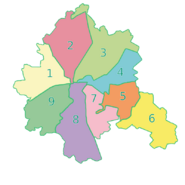 |
|
Kharkiv is divided into 9 administrative districts. Until 2016, many of these districts were named after people or events from the early Soviet Union. However, they were renamed in February 2016 to follow decommunization laws. Over 200 streets in Kharkiv have also been renamed since 2015.
The districts are:
- Kholodnohirskyi (meaning "Cold Mountain")
- Shevchenkivskyi (named after Taras Shevchenko)
- Kyivskyi (named after Kyiv)
- Saltivskyi (named after the Saltivka residential area)
- Nemyshlianskyi
- Industrialnyi (meaning "Industrial")
- Slobidskyi (named after Sloboda Ukraine)
- Osnovianskyi (named after a city neighborhood)
- Novobavarskyi (named after a city neighborhood)
People of Kharkiv
| Historical population | ||
|---|---|---|
| Year | Pop. | ±% |
| 1660 | 1,000 | — |
| 1788 | 10,742 | +974.2% |
| 1850 | 41,861 | +289.7% |
| 1861 | 50,301 | +20.2% |
| 1901 | 198,273 | +294.2% |
| 1916 | 352,300 | +77.7% |
| 1917 | 382,000 | +8.4% |
| 1920 | 285,000 | −25.4% |
| 1926 | 417,000 | +46.3% |
| 1939 | 833,000 | +99.8% |
| 1941 | 902,312 | +8.3% |
| 1941 | 1,400,000 | +55.2% |
| 1941 | 456,639 | −67.4% |
| 1943 | 170,000 | −62.8% |
| 1959 | 930,000 | +447.1% |
| 1962 | 1,000,000 | +7.5% |
| 1976 | 1,384,000 | +38.4% |
| 1982 | 1,500,000 | +8.4% |
| 1989 | 1,609,959 | +7.3% |
| 2001 | 1,470,902 | −8.6% |
| 2011 | 1,446,500 | −1.7% |
| January 2022 | 1,421,125 | −1.8% |
| March 2022 | 400,000 | −71.9% |
| June 2022 | 750,000 | +87.5% |
| November 2022 | 1,100,000 | +46.7% |
In 1989, Kharkiv had a population of about 1.6 million people. By 2023, the population was around 1.43 million. Kharkiv is the second-largest city in Ukraine, after the capital, Kyiv.
Ethnic Groups
| Ethnic group | 1897 | 1926 | 1939 | 1959 | 1989 | 2001 |
|---|---|---|---|---|---|---|
| Ukrainians | 25.9% | 38.6% | 48.5% | 48.4% | 50.4% | 62.8% |
| Russians | 63.2% | 37.2% | 32.9% | 40.4% | 43.6% | 33.2% |
| Jews | 5.7% | 19.5% | 15.6% | 8.7% | 3.0% | 0.7% |
Languages Spoken
The main language spoken in Kharkiv is Russian. Even after Ukraine became independent, many people, both ethnic Russians and Ukrainians, continued to use Russian.
According to a 2001 census, about 31.77% of the people in Kharkiv spoke Ukrainian as their native language. About 65.86% spoke Russian. A survey in 2023 found that 16% of people spoke Ukrainian at home, and 78% spoke Russian.
Religion in Kharkiv
Kharkiv is an important religious center in Eastern Ukraine.
There are many old and new religious buildings in the city. The Assumption Orthodox Cathedral was built in the 1680s. The Annunciation Orthodox Cathedral, completed in 1888, is one of the tallest Orthodox churches in the world.
Kharkiv also has a Jewish population of about 8,000 people. They are served by the old Kharkiv Choral Synagogue, which was fully renovated between 1991 and 2016. There are also two mosques in Kharkiv, including the Kharkiv Cathedral Mosque.
Kharkiv's Economy
Kharkiv has a diverse economy. This means it has many different types of jobs and businesses. These include financial services, manufacturing, tourism, and high technology.
Industrial Companies
During the Soviet era, Kharkiv was a huge center for industrial production. After the Soviet Union broke apart, the city's defense-focused industries slowed down. However, in the early 2000s, industries started to recover. They adapted to the new market economy.
Large state-owned companies like Turboatom and Elektrovazhmash make heavy power equipment. The Antonov plant produces multi-purpose aircraft. The Malyshev factory makes armored vehicles and harvesters. Khartron designs control systems for space and commercial uses.
IT Industry
Kharkiv is a major hub for the IT (Information Technology) industry in Ukraine. As of April 2018, there were 25,000 IT specialists in the region. Most of them work in computer programming. Kharkiv is the second-largest IT location in Ukraine, after Kyiv.
Many IT companies in Kharkiv work for clients outside Ukraine. Over 95% of their sales in 2017 came from overseas. Their main markets are North America and Europe.
Shopping and Markets
Kharkiv has many large, modern shopping malls.
There are also several big markets:
- Barabashovo Market, which is the largest market in Ukraine and one of the biggest in Europe.
- Tsentralnyi Market
- Kinnyi (Horse) Market
- Sumskyi Market
Science and Education
Higher Education
The Vasyl N. Karazin Kharkiv National University is a very respected university. It was founded in Kharkiv in 1804–1805.
Kharkiv has 13 national universities and many other schools. These schools offer a wide range of subjects. Some of the major universities include:
- Kharkiv National University
- National Technical University "KhPI"
- Kharkiv National University of Radioelectronics
- Yaroslav Mudryi National Law University
- Kharkiv National Aerospace University "KhAI"
- Kharkiv National Medical University
More than 17,000 teachers and researchers work in Kharkiv's higher education institutions.
Scientific Research
The city has many research institutions. These are often connected to the universities. There are three national science centers and 20 national research institutions. About 26,000 scientists work in research and development in Kharkiv.
Famous scientific schools, like the theoretical physics school and the mathematical school, started in Kharkiv.
Public Libraries
The Kharkiv State Scientific V. Korolenko-library is a major research library. There are also libraries at all the universities and research institutions.
Secondary Schools
Kharkiv has 212 secondary schools. This includes 10 lyceums and 20 gymnasiums.
Culture in Kharkiv
Kharkiv is one of Ukraine's main cultural centers. It has 20 museums, over 10 theaters, and many art galleries. Large music and film festivals are held in Kharkiv almost every year.
Theaters
The Kharkiv National Academic Opera and Ballet Theatre is the biggest theater in the city.
The Kharkiv Ukrainian Drama Theatre is also very popular. The Kharkiv Academic Drama Theatre was recently renovated. Until 2023, it was named after a Russian poet, but its name was changed as part of the derussification campaign.
Kharkiv also has one of the oldest theaters for children, the Theatre for Children and Youth. The Kharkiv Puppet Theatre was created in 1935.
Literature
In the 1930s, Kharkiv was a very important place for writers. Many famous Ukrainian writers worked here. Sadly, over 100 of these writers were arrested and killed during the 1930s. This tragic event is called the "Executed Renaissance." Today, a literary museum in Kharkiv remembers their work.
Today, Kharkiv is known as a "capital city" for Ukrainian science fiction and fantasy. Many popular writers live here. An annual science fiction convention called "Star Bridge" has been held in Kharkiv since 1999.
Music
The Kharkiv Philharmonic Society has a professional Academic Symphony Orchestra. The Organ Music Hall is located in the Assumption Cathedral. A new Organ Music Hall opened in 2016.
The Kharkiv Conservatory and the Kharkiv National University of Arts are also in the city. Kharkiv hosts the Hnat Khotkevych International Music Competition.
Films
Many feature films have been shot in Kharkiv and its region. One of the most famous is Fragment of an Empire (1929).
Film Festivals
The Kharkiv Lilacs international film festival is very popular. It attracts movie stars and producers from Ukraine and other countries. This festival usually takes place in May. There is a special alley in Shevchenko Park with metal hand prints of popular movie actors.
Visual Arts
Kharkiv has been home to many famous painters, including Ilya Repin and Zinaida Serebryakova. The city has many modern art galleries, such as the Yermilov Centre and the Kharkiv Art Museum.
Museums
There are about 147 museums in the Kharkiv region. Some important museums in the city include:
- The M. F. Sumtsov Kharkiv Historical Museum
- The Kharkiv Art Museum
- The Natural History Museum at V. N. Karazin Kharkiv National University
- The Kharkiv Maritime Museum, which focuses on shipbuilding and navigation history.
- The Kharkiv Puppet Museum, the oldest doll museum in Ukraine.
Famous Landmarks
Kharkiv is known for its churches and its unique Art Nouveau and constructivist buildings:
- Dormition Cathedral, built in the 17th century.
- Pokrovskyi Monastery, built in the 18th century.
- Annunciation Cathedral, built between 1887 and 1901.
- Derzhprom building, a famous constructivist building from 1925–1928.
- Freedom Square, one of the largest city squares in Europe.
- Kharkiv railway station, rebuilt in 1952.
Other popular places to visit include the Taras Shevchenko Monument, Mirror Stream fountain, and the Zoo.
Parks and Green Spaces
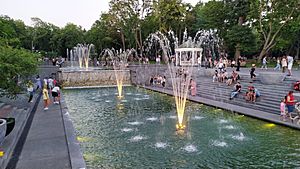
Kharkiv has many parks and gardens. These include Central Park, Shevchenko Park, and Feldman Ecopark. Central Park is a popular place for fun activities for both locals and visitors. Shevchenko Park is near the V.N. Karazin National University. It is a favorite spot for students and professors.
The Ecopark attracts kids, parents, and tourists. Sarzhyn Yar is a natural area that is now a modern park. It has a mineral water source and a sports court.
Transportation in Kharkiv
Kharkiv is a major transportation center in Ukraine. It is connected to many cities around the world by air, rail, and road. There are about 250,000 cars in the city. Kharkiv is one of only four Ukrainian cities that has a subway system.
Local Transportation
Kharkiv has many ways to get around. The Kharkiv Metro is the city's subway system. It opened in 1975 and has three lines with 30 stations. Kharkiv's buses carry about 12 million passengers each year. Trolleybuses, trams, and marshrutkas (private minibuses) are also important for getting around the city.
Railways
The first railway connection to Kharkiv opened in 1869. The first train arrived from the north on May 22, 1869. Kharkiv's passenger railway station was rebuilt in 1901 and again in 1952 after being destroyed in World War II.
Kharkiv has regular train services connecting it to all major cities in Ukraine and other countries. Local trains, called elektrychkas, connect Kharkiv with nearby towns and villages.
Air Travel
Kharkiv is served by Kharkiv International Airport. You can also find charter flights there. The Kharkiv North Airport is a factory airfield and was a major production site for Antonov aircraft.
Sports in Kharkiv
Kharkiv International Marathon
The Kharkiv International Marathon is a big international sports event. It brings thousands of professional athletes, young people, students, and tourists to Kharkiv.
Football (Soccer)
Football (soccer) is the most popular sport in Kharkiv. The city has several football clubs that play in Ukrainian national competitions. The most successful club is FC Dynamo Kharkiv.
Some of the football clubs include:
- FC Metalist Kharkiv
- FC Metalist 1925 Kharkiv
- FC Arsenal Kharkiv
There is also a women's football club, WFC Zhytlobud-1 Kharkiv. This club has represented Ukraine in European competitions.
The Metalist Stadium hosted three group matches during the UEFA Euro 2012 tournament.
Other Sports
Kharkiv has also had ice hockey clubs. There are men's volleyball teams, Lokomotyv Kharkiv and Yurydychna Akademiya Kharkiv.
RC Olymp is the city's rugby union club. Many players from this club play for the national team.
Tennis is also popular in Kharkiv. There are many professional tennis courts. Elina Svitolina, a famous tennis player, is from Kharkiv.
Horse riding is also popular. There are large stables and facilities at Feldman Ecopark. There is also a growing interest in cycling. The city has a large bicycle producer, the Kharkiv Bicycle Plant. A modern bicycle highway is being built in the "Leso park" area.
Famous People from Kharkiv
Many notable people have come from Kharkiv or lived there:
- Serhii Babkin (born 1978) – singer and actor
- Nikolai P. Barabashov (1894–1971) – astronomer
- Maria Burmaka (born 1970) – Ukrainian singer
- Leonid Bykov (1928–1979) – Soviet actor and film director
- Valentina Grizodubova (1909–1993) – one of the first female pilots in the Soviet Union
- Lyudmila Gurchenko (1935–2011) – Soviet and Russian actress and singer
- Mikhail Gurevich (1892–1976) – Soviet aircraft designer (co-founder of MiG)
- Diana Harkusha (born 1994) – Miss Ukraine Universe 2014
- Vasily Karazin (1773–1842) – founder of National University of Kharkiv
- Hnat Khotkevych (1877–1938) – writer, ethnographer, composer
- Mikhail Koshkin (1898–1940) – chief designer of the T-34 Soviet tank
- Les Kurbas (1887–1937) – movie and theater director
- Eduard Limonov (1943–2020) – writer and poet
- Boris Mikhailov (born 1938) – photographer
- Phạm Nhật Vượng – Vietnamese entrepreneur and first billionaire, started business in Kharkiv
- Justine Pasek (born 1979) – Miss Universe 2002
- Henryk Siemiradzki (1843–1902) – painter
- Hryhorii Skovoroda (1722–1794) – poet and philosopher
- Karina Smirnoff (born 1978) – world champion dancer
- Otto Struve (1897–1963) – Russian-American astronomer
- Serhiy Zhadan (born 1974) – Ukrainian poet and novelist
Nobel and Fields Prize Winners
- Élie Metchnikoff (1845–1916) – zoologist, won the 1908 Nobel Prize in Physiology or Medicine
- Simon Kuznets (1901–1985) – economist, received the 1971 Nobel Memorial Prize in Economic Sciences
- Lev Landau (1908–1968) – physicist, won the Nobel Prize in Physics in 1962
- Vladimir Drinfeld (born 1954) – mathematician, awarded the Fields Medal in 1990
Sister Cities
Kharkiv has sister city relationships with many cities around the world. This means they share cultural and economic ties.
- Albuquerque, USA (2023)
- Bologna, Italy (1966)
- Brno, Czech Republic (2005)
- Cetinje, Montenegro (2011)
- Cincinnati, United States (1989)
- Daejeon, South Korea (2013)
- Daugavpils, Latvia (2006)
- Debrecen, Hungary (2016)
- Gaziantep, Turkey (2011)
- Geroskipou, Cyprus (2018)
- Jinan, China (2004)
- Kaunas, Lithuania (2001)
- Kutaisi, Georgia (2005)
- Lille, France (1978)
- Maribor, Slovenia (2012)
- Nuremberg, Germany (1990)
- Polis, Cyprus (2018)
- Poznań, Poland (1998)
- Rishon LeZion, Israel (2008)
- Tbilisi, Georgia (2012)
- Tianjin, China (1993)
- Tirana, Albania (2017)
- Trnava, Slovakia (2013)
- Turku, Finland (2022)
- Varna, Bulgaria (1995)
Images for kids
See also
 In Spanish: Járkov para niños
In Spanish: Járkov para niños


